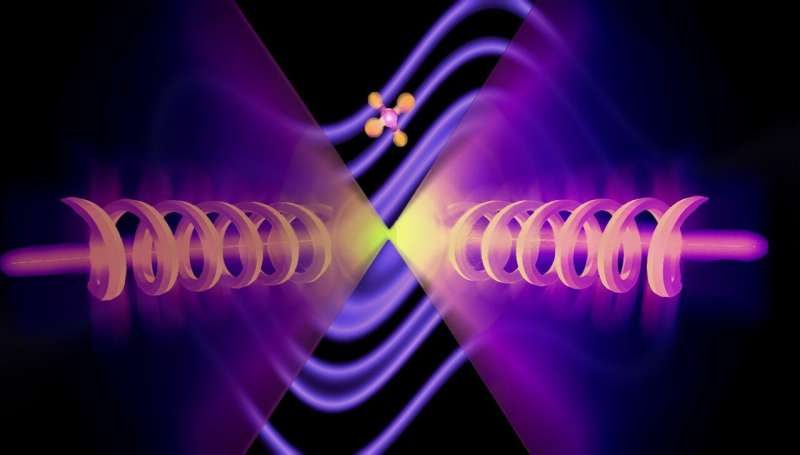This article has been reviewed according to Science X's editorial process and policies. Editors have highlighted the following attributes while ensuring the content's credibility:
fact-checked
peer-reviewed publication
trusted source
proofread
Boomerang-like beams of light: Research makes progress toward observing quantum backflow in two dimensions

Researchers at the University of Warsaw's Faculty of Physics have superposed two light beams twisted in the clockwise direction to create anti-clockwise twists in the dark regions of the resultant superposition. The results of the research have been published in Optica. This discovery has implications for the study of light-matter interactions and represents a step towards the observation of a peculiar phenomenon known as a quantum backflow.
"Imagine that you are throwing a tennis ball. The ball starts moving forward with positive momentum. If the ball doesn't hit an obstacle, you are unlikely to expect it to suddenly change direction and come back to you like a boomerang," notes Bohnishikha Ghosh, a doctoral student at the University of Warsaw's Faculty of Physics. "When you spin such a ball clockwise, for example, you similarly expect it to keep spinning in the same direction."
However, everything gets complicated when, instead of a ball, we are dealing with particles in quantum mechanics. "In classical mechanics, an object has a known position. Meanwhile, in quantum mechanics and optics, an object can be in the so-called superposition, which means that a given particle can be in two or more positions at the same time," explains Dr. Radek Lapkiewicz, head of the Quantum Imaging Laboratory at the Faculty of Physics, University of Warsaw.
Quantum particles can behave in quite the opposite way to the aforementioned tennis ball—they may have a probability to move backwards or spin in the opposite direction during some periods of time. "Physicists call such a phenomenon backflow," Bohnishikha Ghosh specifies.
Backflow in optics
Backflow in quantum systems has not been experimentally observed so far. Instead, it has been successfully achieved in classical optics, using beams of light. Theoretical works of Yakir Aharonov, Michael V. Berry and Sandu Popescu explored the relation between backflow in quantum mechanics and the anomalous behavior of optical waves in local scales.
Y. Eliezer et al. observed optical backflow by synthesizing a complex wavefront. Subsequently, in Dr. Radek Lapkiewicz's group, Dr. Anat Daniel et al. have demonstrated this phenomenon in one dimension using the simple interference of two beams.
"What I find fascinating about this work is that you realize very easily how things are getting weird when you enter the kingdom of local scale measurements," says Dr. Anat Daniel.
In their paper "Azimuthal backflow in light carrying orbital angular momentum," researchers from the Faculty of Physics, University of Warsaw, have shown the backflow effect in two dimensions. "In our study, we have superposed two beams of light twisted in a clockwise direction and locally observed counterclockwise twists," explains Dr. Lapkiewicz.
To observe the phenomenon, the researchers used a Shack-Hartman wavefront sensor. The system, which consists of a microlens array placed in front of a CMOS (complementary metal-oxide semiconductor) sensor, provides high sensitivity for two-dimensional spatial measurements.
"We investigated the superposition of two beams carrying only negative orbital angular momentum and observed, in the dark region of the interference pattern, positive local orbital angular momentum. This is the azimuthal backflow," says Bernard Gorzkowski, a doctoral student in the Quantum Imaging Laboratory, Faculty of Physics.
It is worth mentioning that light beams with azimuthal (spiral) phase dependence that carry orbital angular momentum were first generated by Marco Beijersbergen et al. experimentally in 1993 using cylindrical lenses.
Since then, they have found applications in many fields, such as optical microscopy or optical tweezers, a tool that allows comprehensive manipulation of objects at the micro- and nanoscale, whose creator, Arthur Ashkin, was honored with the 2018 Nobel Prize in Physics. Optical tweezers are currently being used to study the mechanical properties of cell membranes or DNA strands or the interactions between healthy and cancer cells.
When physicists play Beethoven
As the scientists emphasize, their current demonstration can be interpreted as superoscillations in phase. The link between backflow in quantum mechanics and superoscillations in waves was first described in 2010 by Professor Michael Berry, a physicist from the University of Bristol.
Superoscillation is a phenomenon that refers to situations where the local oscillation of a superposition is faster than its fastest Fourier component. It was first predicted in 1990 by Yakir Aharonov and Sandu Popescu, who discovered that special combinations of sine waves produce regions of the collective wave that wiggle faster than any of the constituents.
Michael Berry, in his publication "Faster than Fourier," illustrated the power of superoscillation by showing that, in principle, it's possible to play Beethoven's Ninth Symphony by combining only sound waves with frequencies below 1 Hertz—frequencies so low that they wouldn't be heard by a human. This is, however, highly impractical because the amplitude of waves in the super-oscillatory regions is very small.
"The backflow we presented is a manifestation of rapid changes in phase, which could be of importance in applications that involve light–matter interactions such as optical trapping or designing ultra-precise atomic clocks," says Bohnishikha Ghosh. Apart from these, the publication of the group from the Faculty of Physics, University of Warsaw, is a step in the direction of observing quantum backflow in two dimensions, which has been theoretically found to be more robust than one-dimensional backflow.
More information: Bohnishikha Ghosh et al, Azimuthal backflow in light carrying orbital angular momentum, Optica (2023). DOI: 10.1364/OPTICA.495710
Journal information: Optica
Provided by University of Warsaw




















